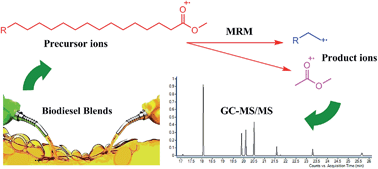Quantification of FAMEs in biodiesel blends of various sources by gas chromatography tandem mass spectrometry†
Abstract
Biodiesel is a renewable, cheaper and environmentally friendly energy source which is gradually replacing diesel fuel and is widely being used in a blended form with diesel. In this study, biodiesels (B-100) from various sources including corn, sunflower, soyabean, rapeseed, peanut, coconut, castor seeds, cotton seeds, linseed, neem tree seeds, waste cooking oil and microalgae were produced by the base catalyzed transesterification reaction. Biodiesel–diesel blends (B-2, B-5 and B-20) and biodiesel–biodiesel blends (BB-2, BB-5, BB-20 and BB-100) were prepared (v/v). A quantification method for saturated and unsaturated fatty acid methyl ester (FAMEs) by gas chromatography tandem mass spectrometry (GC-MS/MS) in multiple reaction monitoring (MRM) mode was developed and validated in the biodiesels and their blends. Linear relationships between the concentration and the corresponding peak area were found over the concentration range of 50–500 μg mL−1 with a good correlation coefficient (r2) of ≥0.96 in all cases. The precision never exceeded 5.5% with good assay accuracy. The main advantage of the developed GC-MS/MS method is the effective separation and quantification of FAMEs in complex samples of biodiesel–diesel blends.


 Please wait while we load your content...
Please wait while we load your content...